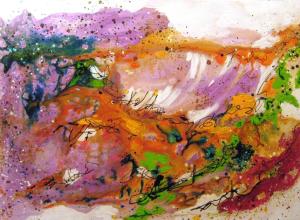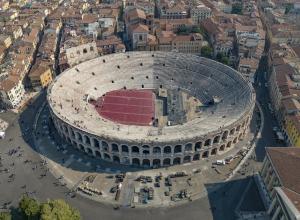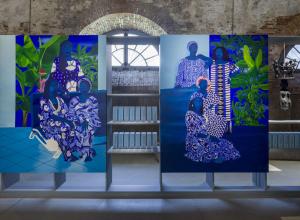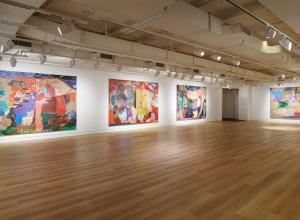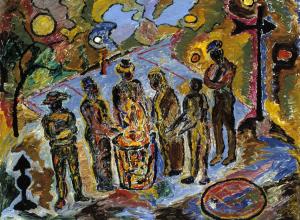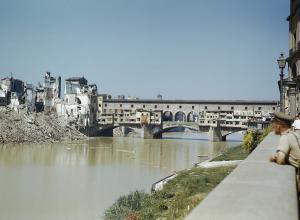The highlight of the auction is a garden picture by August Macke from 1912 which has never been shown in public, and has been in private ownership for many years (400/500,000). Further highlights include: Paul Klee with a paste picture on paper from 1933 (130/180,000), Philipp Bauknecht with a strongly coloured flower still life (100/120,000) and Emil Nolde with two watercolours including a vibrantly coloured marsh landscape at Seebüll (up to 140/160,000). A composition from Serge Poliakoff is valued at 120/140,000, a portrait of a woman by Edward Cucuel at 80/120,000, and at 80/100,000 are a bronze by Henri Laurens and a view of Montmartre by Maurice Urtillo.
Leading the broad offering is August Macke's important painting Kaffeetafel im Grünen from 1912. The garden of the house and studio in Bonn played a central role in the Macke family – as shown in photographs and a large number of drawings, watercolours and paintings by the artist. The present painting is a narrative family portrait as well as testimony to Macke's extraordinary talent to portray the presence of the everyday in the world beyond visible appearance. As a tangible idyll, Kaffeetafel im Garten transcends abruptly the forms of the family's everyday life to the ideas of that new age of spirituality, which Macke had anticipated, just like his contemporaries Wassily Kandinsky or Franz Marc. In the overcoming of materialism and the transition to the new age of spirituality in art lies a central moment in the creativity of the Blaue Reiter artist, whose historical almanac appeared in May 1912. Macke was also represented in this almanac with his short story 'Die Masken' (the Masks), where he spreads his conviction of the manifestation of ''incomprehensible ideas in comprehensible forms. In this sense, the intimate representation of the garden stands for the idea of an earthly paradise (lot 260, 400/500,000).
Paul Klee executed Koniferen im Park in paste colour on paper in 1933. The discussion with nature was an essential part of Klee's work. One witness to his deep interest in botany is his wide-ranging nature collection of pressed and dried pants, which shaped the artist's process of form-finding for many years. Beyond this systematic occupation with the plant world, he was also always inspired by the designed forms of nature such as in the park or garden. Between the study and experience of nature; Klee strove for an exploration of reality, sought every process of becoming and growing in which the movements of the world and cosmos reveal themselves (lot 271, 130/180,000).
Philipp Bauknecht's opulent colour explosion Blumenstillleben mit Buch from 1929–1932 is valued at 100/120,000. The artist and art trader Bauknecht grew up first in Barcelona and later in Southern Germany, moving to Davos for health reasons, where he met painters such as Cuno Amiet and Ernst Ludwig Kirchner. Kirchner facilitated exhibition possibilities for his friend Bauknecht in Germany, and also acquired works of his own. Through his Dutch wife whom Bauknecht met in Davos, works by the artist came to the Netherlands after his early death where they were made accessible to the public first in 1961 by the endeavour of Joop Smids in his Gallery Monet in Amsterdam (lot 269).
With a bold palette of red, yellow and black, Composition abstraite from 1957 by Serge Poliakoff largely eliminates the graduation of the picture space in the foreground and background and emphasizes even further Poliakoff's typical method of superimposing individual colours and forms. It is a power struggle of the different colour segments defined by an emphatically charged tectonic structure to develop that stillness which was so important to Poliakoff (lot 285, 120/140,000). Im Atelier by Edward Cucuel, painted in 1920, has an estimate of 80/120,000. In 1907 he became a member of the Munich artists association ''Scholle'' where he also met Leo Putz, whose plein-air painting and portraits of women would have a lasting influence on Cucuel's work. The present painting impressively displays his skilled handling of the paint which for him represents a physical material and simultaneously a vehicle of light's expression (lot 276). La jeune fille by Henri Laurens is a 38 cm high bronze from 1950. Laurens belonged to the most prominent sculptors of the 20th century. Alongside his work with cubism, Laurens's sculptural and graphic work primarily focused on persistently dealing with and artistically transforming the human figure. As a sculptor Henri Laurens was particularly interested in the finding of form, and his nudes are thus always also to be understood as suggested solutions to sculptural problems (lot 284, 80/100,000). La Place Saint-Pierre et le Sacré Coeur de Montmartre by Maurice Utrillo from 1938 has the same estimate, transporting the viewer to Paris of the 1930s (lot 281, 80/100,000).
An unusual but characteristic Buste de Femme made in early 1929 by Jean Léon Fautrier is valued at 50/60,000 (lot 272). Estimates of 40/50,000 have been given to a high quality work by Maria Mela Muter (Frau im Pelzkragen from 1919, lot 254) and Herman Glöckner's Rechtwinklige Durchdringung, a double-sided abstract geometric panel from 1932, rarely seen on the market (lot 276). Also estimated at 40/50,000 is Cuno Amiet's noteworthy Selbstbildnis (Selbstportrait vor Bergkette) from 1932 (lot 277), as is a neo-impressionist portrait of the important French-Belgian writer Émile Verhaeren by Louis Hayet (around 1894–1896, lot 252).
Amongst the sculptures shines Ernst Barlach's Der singende Mann from 1928, a hitherto unknown zinc cast from 1940. This cast was probably commissioned in 1940 by Barlach's longstanding secretary and assistant Bernhard A. Böhmer to the Hermann Noack foundry in Berlin. With its exceptionally beautiful, open pose and his devoted expression, the sculpture of "Singender Man" is to be counted among the incunabula of German sculpture and among the masterpieces within Barlach's oeuvre (lot 266, 70/90,000). Further sculptures offered include a bronze work by Georg Kolbe (Kauernde, 30/40,000) and Ewald Mataré's Tänzelndes Pferd – Chinesisches Pferd, (35/40,000).
Jean de Fiennes, vêtu, réduction by August Rodin is from the group of the 'Bourgeois de Calais'; a documented cast of the last edition by the Musée Rodin; it is one example cast by Georges Rudier between 1956 and 1963 (lot 250, 40/50,000).
The expressionist graphics are shaped by Franz Marc's 1913 tempera Landschaft bei Meran (Schenna) at 30,000 (lot 257), and a drawing of sheep from 1905 (lot 285, 25/30,000), a charcoal drawing by August Macke from 1911 (lot 259, 30/40,000), and Badende, painted three years later by Ernst Ludwig Kirchner (lot 265, 40/45,000). Otto Dix is represented by two gouaches from 1916 and 1925 (lots 267/268, up to 50,000). An important colour pencil drawing from 1919, a Keltisches Dorf by Paul Adolf Seehaus, is a large-format, colourful sheet of high quality, one of the masterpieces of this artist's oeuvre, and offered at 25/30,000 (lot 262). Elbbrücke III is a rare etching from the 'Hamburger Brücken' series from 1932 by Rolf Nesch, with a Gustav Schiefler provenance (lot 273, 20/25,000).




